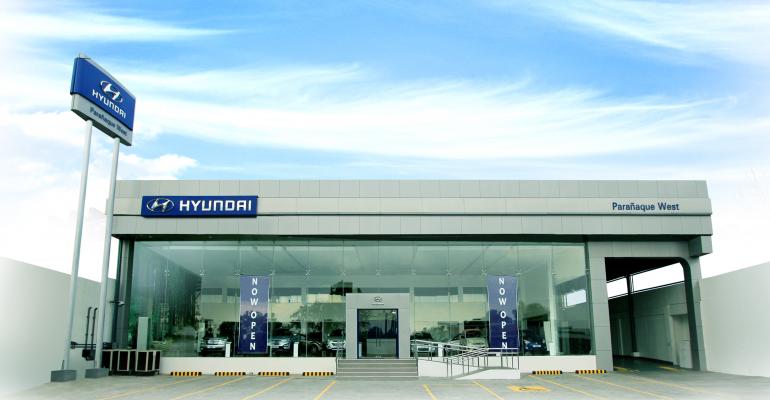Sweeping tax reforms introduced by Philippines President Rodrigo Duterte designed to raise funds for infrastructure improvements may cool a protracted vehicle sales boom in the country, experts say.
The first changes under the Tax Reform for Acceleration and Inclusion Law (TRAIN) took effect in January. The resulting higher excise taxes saw sales of passenger cars and commercial vehicles drop by 9.5% and 8%, respectively, in the first quarter of the year compared to January-March 2017, according to the Chamber of Automotive Manufacturers of the Philippines and the archipelago’s Truck Manufacturers Assn.
This most likely means 2018 will end a streak of eight consecutive years with strong vehicle sales growth fueled by GDP growth that is among Asia’s highest; the World Bank projects this will be 6.74% this year.
Philippine light-vehicle (car and van) sales increased 18.1% in 2017 to 457,679 units, with Toyota, Mitsubishi, Ford, Hyundai and Honda grabbing 41%, 12%, 8%, 8% and 7% of the LV market, respectively, according to data from market researcher IHS Markit.
“Q1 sales were still cushioned by dealers using stock inventory with the old price tag, so the April data will be more interesting to look at,” Jessada Thongpak, manager-ASEAN vehicle forecasting at IHS Markit, based in Bangkok, says in an interview with WardsAuto.com.
“However, as OEMs don’t want to lose market shares, they will be offering incentives, such as extended-warranty, extra accessories and maintenance services, so at the end of the day the price for value will be not so different from last year,” he adds.
Although TRAIN includes personal-income-tax cuts that will translate into more spending power for the middle income-bracket, IHS Markit forecasts the Philippines’ LV market to grow only 1.2% in 2018.
The new, four-tiered tax regime imposes a 4% excise tax on most non-hybrid cars and vans with a retail price of under PHP600,000 ($11,500).
For non-hybrids between PHP600,000 and PHP1 million ($19,350), a 10% excise tax applies, while non-hybrids in the PHP1 million to PHP4 million ($77,400) bracket and non-hybrids over PHP4 million will be subject to 20% and 50%, respectively.
Hybrid vehicles are subject to only 50% of the tax per segment, while all-electric vehicles and pickup trucks of any engine type are exempted.
A straightforward comparison with the old scheme is tricky, given its complexity, but according to the Philippines’ Association of Vehicle Importers and Distributors (AVID), the new regime results in uneven impact across the segments and even within them, with retail prices in the first-tier bracket growing about 2%, while the second tier will see increases of up to 8%.
The bottom of the third tier will see the highest growth, of around 10%, whereas vehicles between PHP2 million ($38,700) and PHP6.6 million ($127,600) will see their suggested retail prices fall by up to 12%.
Ferdinand Raquelsantos, president of the Philippine Parts Maker Assn., and IHS’ Thongpak believe the effect will be even for the mostly Japanese-branded CKDs (complete-knocked-down units) that are assembled in the Philippines and the mostly Japanese-branded CBT (completely-built-up exports) imported from Thailand and Indonesia, the latter duty-free under ASEAN Economic Community free-trade rules.
Raquelsantos says the real winners are locally assembled electric vehicles, including jeepneys, the most popular means of public transportation in the Philippines.
“The tax advantage benefits production of e-jeepneys and e-trikes (motorized tricycles), which our members supply,” Raquelsantos says.
“This fits in well with the government’s new public-utility-vehicle modernization program,” he says, noting its goal of phasing-out jeepneys, buses and other public utility vehicles that are at least 15 years old by 2020.
Looking ahead, there are indicators that the next big game change in the Philippine auto market could be the tariff-free entry of South Korean cars.
Although a South Korea-ASEAN free-trade agreement has been in effect since 2007, it does not cover cars, so South Korean cars still are subject to Philippine import tariffs.
Local Philippines assembly by South Korean automakers still is in its infancy, with Hyundai’s local distributor Hyundai Asia Resources in early April announcing it is investing PHP5 billion ($95 million) over the next five years to assemble models in the Philippines, running full CKD operations by June and commercial production by September.
Hyundai Asia Resources has not identified the model that initially will be built locally.
“I heard rumors that there have been high-level talks between Korean OEMs and the Philippine government over possible tariff-free treatment,” IHS Global’s Thongpak says. “That would be very beneficial for Hyundai and Kia, which together currently only have a market share of around 10% in the Philippines and less than 5% in the whole of Southeast Asia.”
Indeed, Philippine consumers’ tremendous appetite for South Korean cars is suggested by data showing Hyundai posted 4% year-on-year growth in the first quarter, despite the Philippines’ higher excise tax.





